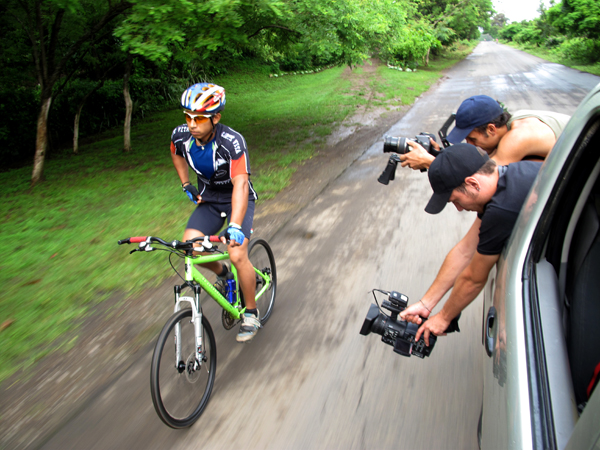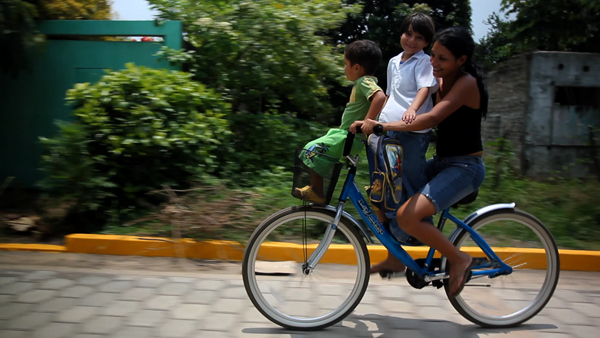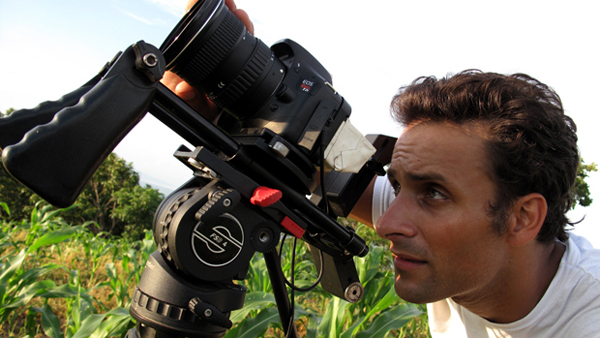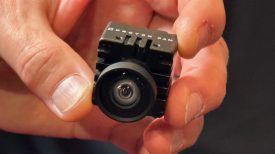The Bicycle City. Trailer from Greg Sucharew on Vimeo.

Last summer we traveled to Nicaragua to shoot the footage for what will soon be a feature-length documentary about the remarkable town of Rivas. We had almost no budget, were filming in a foreign country, and two of the three of us didn’t speak the language. But the more we heard about Rivas, the more we wanted to share its story with the world.
Nicaragua is a nation that endured many long years of military dictatorship before it erupted in a bloody civil war. When the smoke cleared, civil infrastructure and economic opportunity were casualties of the fighting. For the common Nicaraguan, employment was scarce and the capital to start a business nonexistent.
That began to change in the early 1990s, after a returned Peace Corps volunteer from New Jersey decided he would collect used bicycles in America and ship them to impoverished areas overseas as a form of economic aid. He founded a nonprofit organization, Pedals for Progress (www.p4p.org), and the Nicaraguan town of Rivas became one of the main recipients of his bikes. Today, after two decades of receiving bicycles, Rivas has a vibrant marketplace. People are able to find employment, get to work and school, and the community is more cohesive—all due to the mobility citizens gained by having two wheels to ride on.

Because Nicaragua is still one of the poorest countries in the Western hemisphere, we needed to choose our gear carefully. We knew professional film and video equipment would be unavailable locally so we had to bring in everything we would need, including back-ups and replacements. A number of factors dictated what we required: budget, the small size of our crew, durability, and the necessary mobility to allow us to follow Nicaraguans as they rode their bikes about town.
We decided on bringing two cameras, the Panasonic HPX-170, and the Canon T2i. The 170 offered us the benefits of the traditional video camera – high quality sound, ease of use, and stability. The T2i gave us a DSLR’s ability to change lenses based on shifting shooting environments/objectives, a compact lightweight body, high-resolution video, and the capability to capture still images that made it perfect for time-lapse photography.
While we were almost constantly rolling on both cameras in run-and-gun situations, we chose to lean more heavily on the T2i when possible. Because it gave us more flexibility and a better image than the 170, it was our primary camera for shooting interviews (sound went to the 170), b-roll, and low-light scenes. But it also caused us the most headaches, although some of them could perhaps have been avoided with some better planning on our part.

Our issues with the T2i essentially came down to three things: overheating, an inability to accurately monitor exposure, and an inability to view the LCD screen while shooting from overhead or down low. Overheating, given the relatively high ambient temperatures of Central America, was a constant threat. Often we didn’t have the luxury of turning off the camera when the warning light prompted us. If we’d had the budget, a spare body would have been a great addition to our arsenal. We were frequently forced to wait until the camera shut down from overheating. As you can imagine, this involved a lot of SD card/battery removal, and a lot of lung-power to expedite the cooling process. Overheating occurred mostly during extended interview sessions and the longer bicycle-follows through the streets of Rivas (shot from the seat of a bike taxi).
A cheap Delkin screen hood with the sides gaffed was how we managed to use the T2i’s LCD while shooting in bright light. Even with the hood exposures were often blown out, but after a few weeks of shooting and getting to know the camera we finally managed to compensate for the fact that the screen showed darker than the actual footage and we exposed accordingly.
The LCD also frustrated us when we were shooting bicycles from moving cars and flatbeds—from most angles the T2i forced us to do so without any sort of ability to view our shots. We outfitted for Nicaragua just before the Canon 60D with its new-fangled flip-out screen burst on the scene; that would have been nice for our project. We had no room in the budget for an external monitor to use with our T2i. This was frustrating, but we made do, and used the 170 to get the shots that required hanging over the side of a pick-up truck bed or leaning out of a car window – getting close-ups of pedal strokes and such.

Quite possibly the most important accessory, without which the T2i would have been practically useless, was the Fader ND filter. It allowed us to shoot at a constant f1.4 in full sun using the Sigma 30mm with a shutter speed of 1/50. Using it we were able to get awesome shallow depth of field, and truly intimate footage otherwise unattainable. On an average day the filter was swapped from lens to lens about 30 times. It would often jam on the poor threads of our cheap aluminum step-up rings. We had no spare and had it ever been damaged by impact or thread damage we would have been in a very no bueno situation.
Despite my gripes, the overall experience of shooting with the Canon T2i was great. With the right additions and glass, the image this camera can produce is beautiful. It’s affordable, and most of the equipment necessary to use it effectively is too. And its footage compliments the 170’s quite nicely. Not to get too much into post-production, we were slightly worried at the outset that the footage captured by the different cameras wouldn’t match when intercutting. We found that it did and cuts between the cameras need not be abrupt.
Our trip lasted two months and we were able to get 90% of the ambitious amount of footage we had planned to shoot. Now we are in the editing phase and are working to complete the film as quickly as we can. Take a look at our trailer to see our work with the T2i and 170. We hope you will (soon) enjoy The Bicycle City.
Lenses We Used:
Pentax Super Takumar 50mm/1.4 (Interviews)
Sigma 30mm/1.4 (Low Light Run and Gun)
Sigma 20mm/1.8 (Low Light Run and Gun)
Tokina 11‐16/2.8 (Timelapse, Interior Handheld Action)
Canon 17‐55/2.8 EFS IS (Go to lens)
Necessary bits:
82mm Fader ND filter (plus necessary step up rings for all lenses)
12 Transcend 16GB SDHD cards (48min x 12)
10 LPE8 batteries for T2i (aftermarket from ebay )
Manfrotto 394 quick release plates
Ortlieb waterproof messenger bag
Greg Sucharew, Director
Frank Trotta, Director of Photography
FInd out more about The Bicycle City at http://thebicyclecityfilm.com/






